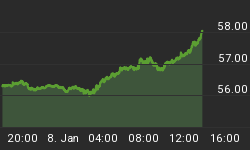More than twenty years after its infamous real estate and equity bubble burst, Japan has been plagued by economic malaise, an ailment most main stream economists have attributed to something they call a deflationary death spiral. As one lost decade turned into two, and now well into number three, Japan's Prime Minister Shinzo Abe has vowed to remedy this deflationary flu with an enormous dose of inflation.
In Japan, they affectionately refer to this elixir as Abenomics. In English, this remedy roughly translates to an enormous injection of public spending, more than a spoonful of currency destruction, chased down with a large dose of a consumption tax.
And, if deflation had actually been what had ailed the Japanese economy - it would appear that after more than two decades, they finally found their cure. The price of food is soaring at the fastest pace in 23 years and core consumer prices jumped 3.2 percent YOY in April.
Unfortunately, those Japanese who were only sick of the stagnant economy, are starting to wonder if "Dr. Abe" misdiagnosed the original disease. With an economy in perpetual stagnation, slightly falling to stable prices was the one salve. As anyone who lived through the 1970's can avow, low growth can't be assuaged by raising prices. And with wages excluding overtime and bonus payments falling in Japan for a 23rd straight month in April, Japan's economy is falling victim to a new kind of outbreak--stagflation. Stagflation is an inflationary period accompanied by rising unemployment and lack of economic growth.
In fact, a favorite stagflation diagnostic indicator, termed the misery index, which adds the jobless rate (3.6 percent) to overall inflation (3.4 percent), climbed in April to 7--a 33-year high. Rising prices helped push Japan's misery index to the highest level in decades, while wages adjusted for inflation fell the most in more than four years. If inflation continues at this clip, it won't be long before Abe is forced to forego his Abenomic tonic in favor of a bottle of a Japanese version of WIN (Whip Inflation Now) buttons.
The economy is seen contracting an annualized 4.3 percent in the three months through June, following 6.7 percent growth in the first quarter--the surge in Q1 will prove to be temporary because businesses frontloaded capital spending in a move to avoid April's well-anticipated and substantial increase in the consumption tax.
And, as Japan falls sick with the stagflation flu, it's only a matter of time before we see this pandemic spread to Europe, just as it has already infected America. The Japanese prescription for deflation contains the same active ingredients of tax hikes, government spending and money printing that has caused the U.S. economy to begin to resemble that of the 1970's. Indeed, consumer prices across the developed world have already stopped the healthy decline experienced after the real estate bubble burst in 2007, and since have broadly headed higher.
U.S. consumer price inflation is exceeding the 2 percent Fed target as of May; after falling throughout most of 2009. That should have been enough for Ms. Yellen and co. to abruptly end QE and begin to normalize interest rates. However, since growth targets have remained elusive--and will continue to disappoint until central banks stop looking to boost GDP through money printing--the Fed stubbornly clings to its easy monetary policies.
It seems that no matter how overwhelming the evidence is to the contrary, governments cling to the belief that growth comes from inflation. Perhaps the truth is that governments' primary agenda is not to produce growth, but rather to find any excuse to create the massive amount of inflation needed to bail out the insolvent condition of their nations by reducing the value of that debt. Therefore, it is sad to say it's time for Japan, along with Europe and the U.S., to say sayonara to the mollifying condition of deflation and konnichiwa to the dreaded situation of stagflation.
The size of central banks' balance sheets around the globe have massively expanded into record territory in recent years. This should have caused a commensurate increase in the gold price across multiple currencies. Adding to the upward pressure on the yellow metal is the estimate from China's chief auditor that the nation used $15.2 billion worth of phony gold ownership to vastly increase access to credit. Chinese security authorities are also probing alleged fraud involving other metals such as copper and aluminum stockpiles, which have been pledged multiple times in order to expand collateral for loans. This factor has aided the Chinese economy to increase debt 25 fold since the year 2000.
Debt levels have exploded across the world alongside the proclivity of central banks to create record amounts of credit. In addition, real interest rates are profoundly negative and persistent inflation has now become the stated goal from most governments. Most importantly, recently-achieved inflation targets set by the Fed are being completely ignored by Janet Yellen. And finally, the manipulation of prices and fraudulent use of supplies have created a tremendous tailwind for gold values. For these reasons, PPS has recently increased its allocation to gold mining shares in its Inflation/Deflation Dynamic Portfolio.
Michael Pento is the President and Founder of Pento Portfolio Strategies and Author of the book "The Coming Bond Market Collapse."
















